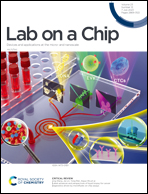Modular droplet injector for sample conservation providing new structural insight for the conformational heterogeneity in the disease-associated NQO1 enzyme†
Abstract
Droplet injection strategies are a promising tool to reduce the large amount of sample consumed in serial femtosecond crystallography (SFX) measurements at X-ray free electron lasers (XFELs) with continuous injection approaches. Here, we demonstrate a new modular microfluidic droplet injector (MDI) design that was successfully applied to deliver microcrystals of the human NAD(P)H:quinone oxidoreductase 1 (NQO1) and phycocyanin. We investigated droplet generation conditions through electrical stimulation for both protein samples and implemented hardware and software components for optimized crystal injection at the Macromolecular Femtosecond Crystallography (MFX) instrument at the Stanford Linac Coherent Light Source (LCLS). Under optimized droplet injection conditions, we demonstrate that up to 4-fold sample consumption savings can be achieved with the droplet injector. In addition, we collected a full data set with droplet injection for NQO1 protein crystals with a resolution up to 2.7 Å, leading to the first room-temperature structure of NQO1 at an XFEL. NQO1 is a flavoenzyme associated with cancer, Alzheimer's and Parkinson's disease, making it an attractive target for drug discovery. Our results reveal for the first time that residues Tyr128 and Phe232, which play key roles in the function of the protein, show an unexpected conformational heterogeneity at room temperature within the crystals. These results suggest that different substates exist in the conformational ensemble of NQO1 with functional and mechanistic implications for the enzyme's negative cooperativity through a conformational selection mechanism. Our study thus demonstrates that microfluidic droplet injection constitutes a robust sample-conserving injection method for SFX studies on protein crystals that are difficult to obtain in amounts necessary for continuous injection, including the large sample quantities required for time-resolved mix-and-inject studies.

- This article is part of the themed collections: Andreas Manz – Pioneer, Mentor, Friend and Lab on a Chip HOT Articles 2023


 Please wait while we load your content...
Please wait while we load your content...